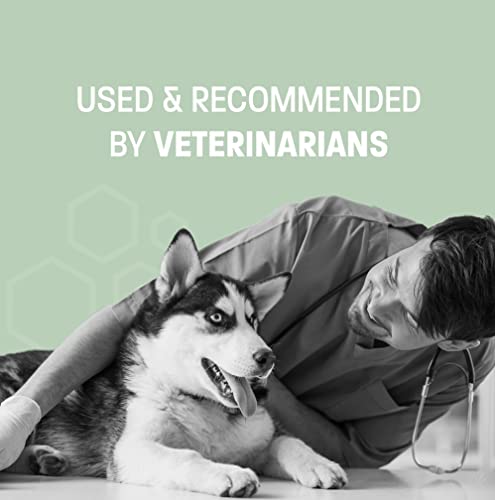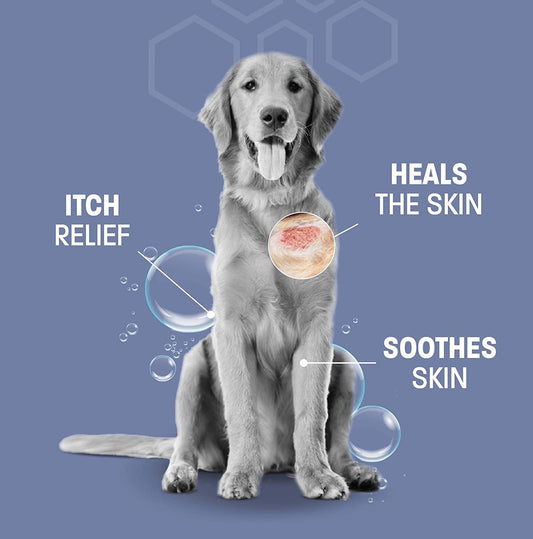In the vast world of pet care products, what makes the medicated solutions of Pet Health Pros shine? Dive in to discover their efficacy against ear yeast infections.
Ear yeast infections are a nuisance for humans and animals, especially dogs. Overgrowth of the fungus known as yeast is the cause of these infections, commonly affecting ears and paws. Thankfully, medicated solutions exist to combat these infections.
Ear yeast infections make our furry friends itchy and uncomfortable. They scratch and shake their heads, leading to further irritation and damage to the ear canal. Antifungal medications target the underlying cause of the infection, helping to eliminate the fungus.
Veterinarians may prescribe oral antifungal medications for more severe cases. It's important to follow the dosage instructions.
Treating yeast infections in dog paws involves a holistic approach. Medicated shampoos or wipes cleanse and moisturize the affected areas while reducing inflammation and itching. Dietary changes may also help address any underlying causes.
Don't let your pet suffer from untreated ear yeast infections! Consult your veterinarian at the first sign of symptoms. Taking action promptly can provide relief and prevent more serious complications. A little intervention now can save your pet from a world of discomfort later. Give your pet the care they deserve.
What are ear yeast infections?
- Yeast infections of the ears can happen when fungus Candida grows too much.
- These infections are common in dogs - their warm, moist ear canals make them vulnerable.
- Itching, redness, and a smelly odor are symptoms of ear yeast.
- Antifungal medication, like creams or drops, are used to treat this type of infection.
It's essential to get vet help if your pup has signs of ear yeast. Fast action with antifungal meds can ease discomfort and avoid further problems.
Bonus Tip: To help avoid ear yeast, use a vet-recommended solution to clean Fido's ears on a regular basis.
Causes of ear yeast infections in dogs
Ear yeast infections in dogs can be caused by various factors. Candida albicans, which is naturally found in the ears, may quickly multiply in the right environment. This environment includes a warm and moist environment; just like an ideal breeding ground for yeast. Allergies, excessive earwax, a weakened immune system, health issues, and improper ear cleaning techniques can also contribute.
To understand it better, consider how these factors interact. For example, allergies often make the ears itchy. Dogs then scratch vigorously, causing small wounds that allow yeast to enter. Excessive earwax can also trap moisture and create a favorable environment for yeast growth.
Paws and ears are also connected. If a dog has a paw infection or allergy, they will frequently lick their paws while grooming. This can transfer yeast from their paws to their ears. Dogs with weaker immunity are more susceptible to developing ear yeast infections.
It's important to address underlying health issues, practice proper ear cleaning techniques, and keep the ears dry and well-ventilated. This helps reduce the risk of ear yeast infections.
Symptoms of ear yeast infections
Ear yeast infections can cause lots of problems for both dogs and humans. It is important to notice them quickly to stop more issues. Here are the usual signs of ear yeast infections:
- Itchy ears that your pup may scratch often
- The outer ear red and swollen
- A bad smell coming from the ears
- Lots of wax or discharge in the ears
- Head shaking or tilting one way
- Maybe hair loss around the ears or on the paws (from too much scratching)
These symptoms can be different, depending on the situation. It is important to take action quickly to give relief and not let the infection spread.
In addition to these common symptoms, you should look out for other details. For example, some dogs may feel pain when their ear is touched. Or, they might lose their balance due to the infection in the inner ear. Knowing these things is important to understand ear yeast infections.
A vet clinic had a dog with a severe ear yeast infection. It was caused by too much time in wet places. The pup was itchy and had skin infections from so much scratching. With the right treatment, the dog was totally fine. This shows how important it is to act quickly when you see signs of an infection.
By knowing the symptoms and getting help right away, you can make sure your pet is comfy and has healthy ears. Keep in mind: fast action is key to treating ear yeast infections.
Importance of medicated solutions in combating ear yeast infections
Medicated solutions can be a life-saver for dogs with ear yeast infections. These antifungal remedies are specially created to stop the growth of yeast and fungus. Applying them directly to the affected area helps ease discomfort and control the overgrowth. Plus, they can be used on paws or other areas prone to fungal infections.
Advances in veterinary medicine mean there are various types of medicated solutions for ear yeast infections. Creams, ointments, and ear drops contain active ingredients that fight fungi. They eliminate excess yeast and restore balance, plus prevent future flare-ups. Some medicated solutions can also be ingested orally or added to food as part of a treatment plan. This ensures the medication reaches all affected areas, both internally and externally.
Remember, if your dog is showing signs like itching or discharge from their ears, talk to a vet. With proper care and the right solution, you can help your furry friend feel better.
Types of medicated solutions for ear yeast infections
Our four-legged friends can experience discomfort & itchiness due to ear yeast infections. To treat this, specific medicated solutions are needed. They provide relief & prevent further issues. Here are the main types:
- Antifungal Drops: Containing powerful ingredients, these combat fungus & offer quick relief.
- Antifungal Ear Wash: Cleans ears & fights yeast infection, plus prevents recurrence.
- Medicated Ointments: Vets may prescribe antifungal ointments to soothe irritation & heal.
- Topical Sprays: A convenient solution for itching, these target areas & provide relief.
- Ear Powders: Natural ingredients with antimicrobial properties reduce inflammation & fight fungus.
- Oral Antifungal Medications: If infection is severe, oral antifungal drugs may be prescribed.
It's important to note that each case may vary. So, consulting a vet is essential. To protect our furry pals, treatment must be prompt. If not, more discomfort & serious complications can occur. Don't let your pup suffer; speak to a vet & explore the medicated solutions available.
How to properly use medicated solutions for ear yeast infections
- Cleanse. Begin by using a gentle cleanser specifically formulated to clean your dog's ears.
- Dry. Make sure the ears are completely dry.
- Apply. Put the prescribed antifungal solution on your dog's infected ears, covering everything.
- Massage. Gently massage the base of the ears to help the medication absorb.
- Repeat. Follow your vet's instructions for frequency and duration of treatment. Consistency is important!
- Monitor. Keep a close eye on your pup's progress and consult a vet if any concerns or complications arise.
Remember: Don't let your dog's paws come in contact with the infected ears. Fungus can spread easily! Also administer any oral medications or supplements prescribed.
Take immediate action and help your pup fight the infection. Your efforts will improve their quality of life and reduce the risk of complications. Act now to protect your pet from pain and discomfort!
Tips for preventing ear yeast infections in dogs
Prevent ear yeast infections in your furry friend! Follow these tips:
- Clean their ears regularly with a vet-recommended cleaner.
- Dry their ears after they swim.
- Feed them a balanced diet with probiotics and less carbs.
Plus, keep their paws clean and dry, 'cause yeast loves moisture.
When to seek veterinary care for ear yeast infections
When it comes to ear yeast infections in dogs, it's important to know when to get vet help. If your pup has:
- Severe itching or discomfort in their ears
- A strong, foul smell coming from their ear
- Redness or swelling around the ear canal
- An abnormal amount of wax or discharge in their ear
- An ear infection that doesn't clear up in a week
- Recurring ear infections that happen often or can't be cleared
Veterinary care is recommended. Plus, if your dog is scratching or shaking their head, it may be an ear yeast infection. Getting help quickly can prevent further issues and give your pet the right treatment.
Untreated ear yeast infections can cause inflammation of the external ear canal or bacterial infections that are more severe. That's why it's so important to get help right away.
Also, according to the AKC, breeds such as Basset Hounds and Cocker Spaniels with floppy ears are more likely to get ear yeast infections.
Conclusion
When it comes to your pet's health, settle for nothing but the best. Rely on Pet Health Pros for targeted and effective relief.
To treat ear yeast infections in dogs, use medicated solutions that target the underlying fungus. Products specifically designed for ears and paws can relieve itchy and uncomfortable symptoms. Follow usage instructions and consult a vet for guidance. Treating ear yeast infections also helps to stop further complications. Otherwise, the fungus can spread and cause damage or secondary infections. So, take action at the earliest signs of infection. In addition, regular grooming can help prevent future yeast infections. Clean your dog's ears with a gentle cleanser that your vet recommends. Also, dry their ears after swimming or bathing to reduce the risk of fungal growth from moisture buildup. Be proactive in caring for your dog's ears. Seek prompt treatment when necessary. Don't let them suffer silently. Addressing ear yeast infections promptly will lead to happier and healthier days ahead for your canine companion.
Frequently Asked Questions
FAQ 1:
Question: What causes ear yeast infections in dogs?
Answer: Ear yeast infections in dogs are often caused by the overgrowth of a fungus called Malassezia. This fungus naturally resides in the ears, but certain factors such as allergies, moisture, or a weakened immune system can lead to its excessive growth and the development of an infection.
FAQ 2:
Question: How do I know if my dog has an ear yeast infection?
Answer: Common signs of an ear yeast infection in dogs include constant itching of the ears or paws, redness or swelling of the ear canal, a foul odor emanating from the ears, dark discharge, and frequent head shaking or tilting.
FAQ 3:
Question: Can I use medicated solutions to treat my dog's ear yeast infection?
Answer: Yes, medicated solutions play a vital role in combating ear yeast infections in dogs. Antifungal solutions specifically formulated for canine use can effectively eliminate the overgrowth of yeast and provide relief to your dog's discomfort.
FAQ 4:
Question: How should I apply medicated solutions to treat my dog's ear infection?
Answer: First, clean your dog's ears using a vet-approved ear cleanser. Then, follow the instructions provided with the medicated solution, which usually involve gently massaging a few drops into the ear canal. It is important to consult your veterinarian for specific guidance on the application process.
FAQ 5:
Question: Can I use over-the-counter antifungal solutions for my dog's ear yeast infection?
Answer: It is recommended to consult your veterinarian before using any over-the-counter antifungal solutions. While some may be safe for use in dogs, others may contain ingredients that can irritate or harm your pet. Your veterinarian can guide you towards the most suitable and effective medicated solution for your dog's specific condition.
FAQ 6:
Question: How can I prevent ear yeast infections in my dog?
Answer: To help prevent ear yeast infections, regularly clean your dog's ears with a veterinarian-recommended ear cleanser, ensure the ears are thoroughly dried after swimming or bathing, maintain a healthy diet that supports immune system function, and address any underlying allergies or other health conditions promptly. Regular veterinary check-ups also help detect and prevent potential ear infections.








